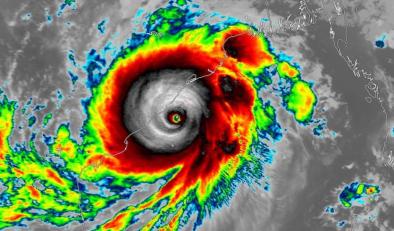Cyclone Fani: The tug-of-war between regional warming and anthropogenic aerosol effects
Study key findings:
- Warming temperatures in the air and at the ocean surface have significantly intensified cyclones in the Bay of Bengal (BoB), especially in the pre-monsoon month of May.
- However, air pollution (aerosols) have also increased in recent years over the BoB. Aerosols (small particles mixed in the air) tend to weaken an existing tropical cyclone, because such particles make clouds rain prematurely (i.e. lighter rain rather than heavy rain) and this process can suppress cyclone growth.
In the case of Fani, the air/sea warming and air pollution formed a tug of war and our study provided a quantitative estimate of how much of the warming-induced intensification of Fani is affected (or countered) by the aerosol-led weakening of the cyclone. We found that the climate warming has won.
- Simon Wang, study co-author
Study abstract:
Cyclone Fani is the strongest pre-monsoon cyclone in the Bay of Bengal (BOB) since 1991, killing 90 people in eastern India and Bangladesh while causing US$1.81 billion of damages in May 2019. Fani developed during a period of high concentration of anthropogenic aerosols in the BOB with abnormally high sea surface temperature (SST), thereby presenting an opportunity to understand the compound effects of atmospheric aerosols and regional climate warming on a tropical cyclone. To this end, a quantitative attribution analysis was conducted using the Weather Research and Forecasting model with chemistry (WRF-Chem) run at the convection-permitting (4 km) grid spacing, accompanied by an ensemble of coarser-resolution simulations to quantify the uncertainty. The removal of post-1990 trends in the tropospheric variables and SST from WRF-Chem's lateral boundary conditions resulted in a reduction of cyclone precipitation by about 51% during the 5 days of April 28-May 2. The removal of tropospheric warming shows approximately twice as strong an effect on Fani (39% reduction in precipitation) as that of SST warming (22% reduction). When aerosol and its direct and indirect effect with radiation and microphysics were removed from the simulations, Fani initially strengthened but later weakened, as measured by geopotential height and precipitation amounts. These results suggest that aerosol and its interaction with the atmosphere acted to mitigate the strengthening effect of anthropogenic warming on Fani, but was not strong enough to entirely counteract it. Although the ensemble of coarser simulations appears to overestimate Cyclone Fani in terms of precipitation, the direction of the effects is in agreement with that obtained from the 4 km simulations. Given the increasing anthropogenic aerosols in the BOB, future attribution studies using more sophisticated dynamical aerosol models on BOB tropical cyclones are urged.



